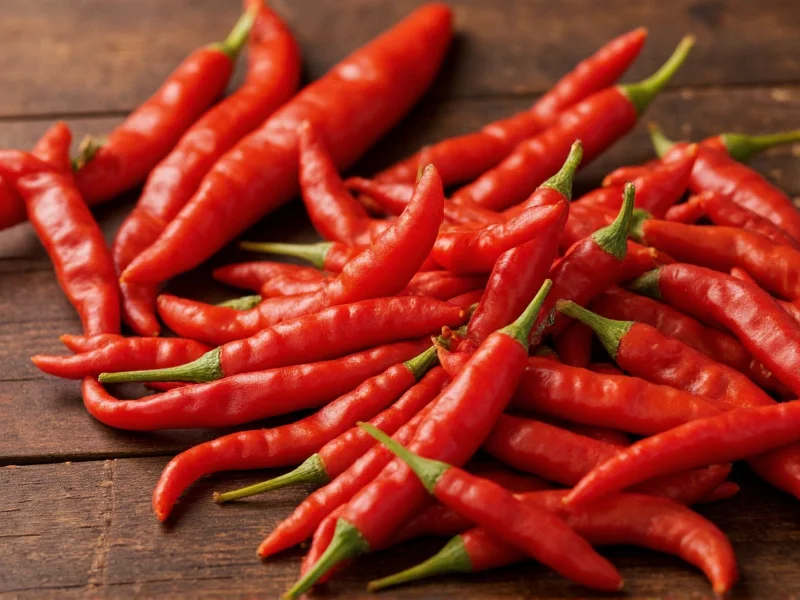The term "shu chilli scale" represents a common misunderstanding of how chili pepper heat is measured. Many people mistakenly refer to the measurement system as the "SHU scale" when in fact, SHU (Scoville Heat Units) is the unit of measurement used on the Scoville scale. Understanding this distinction is crucial for accurately discussing pepper heat levels.
What Is the Scoville Scale?
Developed in 1912 by American pharmacist Wilbur Scoville, the Scoville Organoleptic Test was the first standardized method for measuring chili pepper pungency. Originally, the test involved human tasters diluting chili extract with sugar water until the heat became undetectable. The degree of dilution determined the Scoville rating—1,000 SHU meant the extract had to be diluted 1,000 times before the heat disappeared.
Today, scientists use high-performance liquid chromatography (HPLC) to measure capsaicinoid concentration precisely. This modern method provides objective data that's then converted to Scoville Heat Units for consumer understanding. Despite technological advances, the Scoville scale remains the universal reference for comparing chili heat worldwide.
How the Scoville Scale Works
The Scoville scale measures the concentration of capsaicinoids—the chemical compounds responsible for chili heat. Capsaicin is the primary compound, but others like dihydrocapsaicin also contribute. The scale operates on a logarithmic rather than linear basis, meaning each step represents a significant increase in heat intensity.
Understanding SHU values helps consumers make informed choices. A jalapeño measuring 5,000 SHU isn't just twice as hot as a 2,500 SHU pepper—it's substantially hotter due to the scale's exponential nature. This explains why moving up the scale dramatically increases perceived heat.
Common Peppers and Their Heat Levels
Referencing specific peppers helps contextualize the abstract numbers on the Scoville scale. The table below shows common varieties and their typical heat ranges:
| Chili Pepper | Scoville Heat Units (SHU) | Heat Level Description |
|---|---|---|
| Bell Pepper | 0 SHU | No heat |
| Pepperoncini | 100-500 SHU | Mild |
| Poblano | 1,000-2,000 SHU | Medium mild |
| Jalapeño | 2,500-8,000 SHU | Medium |
| Serrano | 10,000-23,000 SHU | Hot |
| Habanero | 100,000-350,000 SHU | Very hot |
| Ghost Pepper (Bhut Jolokia) | 800,000-1,041,427 SHU | Extremely hot |
| Carolina Reaper | 1,400,000-2,200,000 SHU | World's hottest |
Practical Applications of Scoville Measurements
Chefs and home cooks use Scoville ratings to create balanced dishes. When substituting peppers in recipes, understanding SHU values prevents unexpectedly fiery results. For example, replacing jalapeños (5,000 SHU) with habaneros (200,000 SHU) without adjustment would make a dish 40 times hotter.
Food manufacturers rely on Scoville measurements for product consistency. Hot sauce producers test each batch to maintain consistent heat levels, while snack companies use the scale to create predictable spice experiences in products like spicy chips.
Gardeners selecting pepper varieties benefit from Scoville knowledge too. Those sensitive to heat might choose milder poblanos (1,500 SHU) over serranos (15,000 SHU), while chili enthusiasts might cultivate super-hots like the Carolina Reaper for extreme heat challenges.
Common Misconceptions About Pepper Heat Measurement
Several misunderstandings persist about how we measure chili heat. Many believe "SHU" refers to the scale itself rather than the measurement unit. Others think the Scoville scale has official categories like "mild" or "hot," but these descriptors are informal interpretations of the numerical values.
Another misconception involves variability. A single pepper variety can have a wide SHU range due to growing conditions, soil composition, and climate. A jalapeño might measure 5,000 SHU in one environment but reach 8,000 SHU in another—demonstrating why ranges rather than fixed numbers are used.
Some people also mistakenly believe higher SHU always means better quality. While heat enthusiasts seek extreme values, culinary applications often prioritize flavor balance over maximum heat. Many prized peppers like the fruity habanero offer complex flavors alongside their heat.
Using Scoville Information Responsibly
When handling extremely hot peppers (300,000+ SHU), proper precautions are essential. Capsaicin oils can cause severe skin irritation and respiratory issues. Always wear gloves when preparing super-hots, avoid touching your face, and work in well-ventilated areas.
Consumers should gradually increase heat tolerance rather than jumping to extremely hot peppers. Building tolerance allows appreciation of nuanced flavors that get lost when overwhelmed by intense heat. Remember that individual heat perception varies significantly based on genetics and previous exposure.
Understanding Scoville Ratings in Commercial Products
When purchasing hot sauces or spice products, check for Scoville ratings on the label. Reputable manufacturers provide this information to set consumer expectations. Be cautious of products claiming "X million SHU" without verification—some exaggerate heat levels for marketing purposes.
Consider that processing methods affect perceived heat. Fermentation can mellow some peppers while concentrating capsaicin in others. The presence of sugar, vinegar, or other ingredients also modifies how heat registers on the palate compared to raw SHU measurements.
Frequently Asked Questions
Is SHU the same as the Scoville scale?
No, SHU (Scoville Heat Units) is the measurement unit used on the Scoville scale. The Scoville scale is the measurement system itself, while SHU quantifies the heat level.
How accurate are Scoville ratings for individual peppers?
Scoville ratings represent ranges rather than exact values because heat levels vary within the same pepper variety due to growing conditions, soil, climate, and other environmental factors.
Can I measure SHU at home without special equipment?
No, accurate SHU measurement requires laboratory equipment like HPLC machines. Home taste tests are unreliable and potentially dangerous with hot peppers.
Why do some peppers with the same SHU rating taste differently hot?
Different capsaicinoid compounds affect heat perception differently. Some peppers deliver immediate heat while others have delayed burn. Flavor components and oil content also influence perceived heat.
Does higher SHU always mean better quality in peppers?
Not necessarily. Culinary value depends on flavor complexity, aroma, and heat balance. Many prized peppers like the habanero offer nuanced flavors alongside heat rather than maximum SHU values.











 浙公网安备
33010002000092号
浙公网安备
33010002000092号 浙B2-20120091-4
浙B2-20120091-4